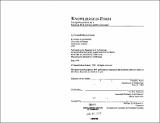| dc.contributor.advisor | Eric Dluhosch. | en_US |
| dc.contributor.author | Knerr, Donald Edward | en_US |
| dc.contributor.other | Massachusetts Institute of Technology. Dept. of Architecture. | en_US |
| dc.date.accessioned | 2012-12-13T18:40:19Z | |
| dc.date.available | 2012-12-13T18:40:19Z | |
| dc.date.copyright | 1989 | en_US |
| dc.date.issued | 1989 | en_US |
| dc.identifier.uri | http://hdl.handle.net/1721.1/75535 | |
| dc.description | Thesis (M. Arch.)--Massachusetts Institute of Technology, Dept. of Architecture, 1989. | en_US |
| dc.description | Includes bibliographical references (p. 105-109). | en_US |
| dc.description.abstract | This thesis is an effort to begin to understand some of the problems and possibilities of architectural production in an age of advanced information technologies. The driving concern behind this work is the increasing distance between our environmental understandings, as they are affected by these new technologies, and the immediate physicality of the world around us. This increasing distance has been further exaggerated by our shift into more and more complex systems of architectural production, making us less and less likely to stay in touch with the full informational content of the physical materials and processes involved in that production. This thesis strives toward an attitude toward design which respects the information and knowledge content of the components and processes of architecture as a complex artifact Part of the attempt here is to consider the opportunities for relaxing the tendency to impose our will insensitively on the true nature of things. It seems that as we alieviate this tendency, we might begin to construct environments which sustain us in more meaningful ways. The thesis itself is composed of six parts: -- Section One discusses developments in the cultural role of museums in recent years and the importance of museums as a way of transferring knowledge. Also introduced in this part is the notion of a host museum; responding to a perceived need for local forums LO foster greater awareness of our physical and cultural environments. -- Section Two introduces the site in Cambridge as an urban setting, including some of its history and its physical and social significance. -- Section Three presents general architectural concerns addressed in the project, illustrated through references and diagrams of design decisions, grouped into five categories of issues, from urban context lO material deployment. -- Section Four elaborates on the setting of these design decisions within the larger context of 'forming', regarding the process of design as a decision structure for the management of physical information. -- Section Five presents the specific design decisions realized in the project (in accord with the five categories established in Section Three) illustrated through plans, sections, detail studies, etc. -- Section Six proposes an understanding of architectural artifacts as manifestations of their decision structure and offers the beginnings of a theory of production based on the exploitation of "cheap information." | en_US |
| dc.description.statementofresponsibility | by Donald Edward Knerr. | en_US |
| dc.format.extent | viii, 109 p. | en_US |
| dc.language.iso | eng | en_US |
| dc.publisher | Massachusetts Institute of Technology | en_US |
| dc.rights | M.I.T. theses are protected by
copyright. They may be viewed from this source for any purpose, but
reproduction or distribution in any format is prohibited without written
permission. See provided URL for inquiries about permission. | en_US |
| dc.rights.uri | http://dspace.mit.edu/handle/1721.1/7582 | en_US |
| dc.subject | Architecture. | en_US |
| dc.title | Knowledge in form : design projections for a museum for learning and environment | en_US |
| dc.type | Thesis | en_US |
| dc.description.degree | M.Arch. | en_US |
| dc.contributor.department | Massachusetts Institute of Technology. Department of Architecture | |
| dc.identifier.oclc | 20668167 | en_US |
